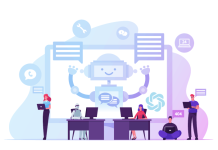
I’m pretty sure, regardless of the size of your center or company, you seek to deliver a great customer experience. And I’m willing to bet your customers have a choice of channels. Unfortunately, I’m almost nearly as confident that your customers sometimes feel pain from their inability to easily cross channels and achieve the coveted “first-contact resolution.” Perhaps employees struggle when they lack visibility into customer activity, can’t get to the right information to solve a problem, or must convey the dreaded “someone will get back to you.”
Technology can be your friend when you invest wisely and implement the tools to their greatest effect. Here are a few recommendations to improve the customer experience.
Smart routing can and should be delivered today. Use what you already know about the customer’s history and current situation to drive data-based, concierge routing and handling that personalizes the customer experience. Customize the prompt structure to play pertinent options only. Route to an appropriately trained agent for the predicted customer need. Ensure the agent greeting and the identification/authentication process acknowledges what you already know and anticipate.
Browser-based interfaces and web services make it far easier to support “screen pops” for customer service representatives. Popping a screen reduces handle time as well as customer effort.
Support web and mobile apps with features that make these channels even more attractive for customer use. Offer website visitors the opportunity to chat with a representative as a sign that you’re genuinely interested in creating a successful interaction. Use SMS/texting for automated, proactive outbound as a way of meeting the customers need before they have to contact you. And given it is a preferred channel for many, consider using SMS/texting for two-way communication as well, with customers or internally (e.g., field personnel) to bring a new level of efficiency to many inquiries and updates.
When a customer moves from the IVR, web, or a mobile app self-service to contact center assisted service, don’t make them restate the information they’ve already entered. This gap is a major customer pain point and a great place to target improvements with the various channel owners. Include IT in the discussion to ensure information is transferred quickly and securely, and integrated into the desktop applications.
Avoid excessive investment in IVR if your customer behavior is transitioning to web and mobile. If IVR is still a strong channel for your vertical and demographics, make sure that your applications are well-designed and command relatively low “customer effort.” Carefully weigh the costs and benefits of speech recognition before taking a bite out of your limited funds and resources.
Success in all of these channels requires extensive data availability. Properly executed, a well-designed CRM solution can engender improved data usage throughout the company, providing one data repository for marketing, sales, and service, across customer relationship and lifetime. Mini-CRM (often labeled “context”) from contact center vendors or cloud-based mid-tier CRM solutions may provide viable options at an affordable price point for smaller centers.
In tandem with CRM, knowledge management (KM) tools can ease the burden on center staff and support customers through web and mobile apps. An effective solution should have good search capability that delivers concise, targeted articles that resolve typical issues and questions. Because source information must be up to date and relevant, the contact center (and enterprise) needs a plan to monitor and manage its knowledge tools.
Finally, the center must have appropriate performance optimization tools to manage its activities. WFO suites are offered by most contact center vendors and typically include QM, WFM, reporting, and some level of analytics. Good reporting is an absolute, with dashboards for real-time and scorecards for historical performance. Speech and text analytics may be further out on your roadmap, but due to the ever-increasing value of collected data, data analytics should be a priority. This tool analyzes data from multiple contact center and company sources, enables drill down, and presents findings in carefully crafted visual aids. Data analytics can build awareness of the underlying business propositions that the contact center supports while giving each layer of management the metrics needed to optimize their roles. And with an enterprise mindset and focus on the overall customer experience and corporate results, you can leverage analytics to a much greater degree.




